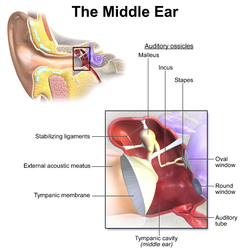Stapedius reflex
| Middle ear | |
|---|---|
 |
|
|
Anatomical terminology
[]
|
The acoustic reflex (also known as the stapedius reflex, middle-ear-muscles (MEM) reflex, attenuation reflex, or auditory reflex) is an involuntary muscle contraction that occurs in the middle ear in response to high-intensity sound stimuli or when the person starts to vocalize.
When presented with a high-intensity sound stimulus, the stapedius and tensor tympani muscles of the ossicles contract. The stapedius stiffens the ossicular chain by pulling the stapes (stirrup) of the middle ear away from the oval window of the cochlea and the tensor tympani muscle stiffens the ossicular chain by loading the tympanic membrane when it pulls the malleus (hammer) in toward the middle ear. The reflex decreases the transmission of vibrational energy to the cochlea, where it is converted into electrical impulses to be processed by the brain.
The acoustic reflex threshold (ART) is the sound pressure level (SPL) from which a sound stimulus with a given frequency will trigger the acoustic reflex. The ART is a function of sound pressure level and frequency.
Individuals with normal hearing have an acoustic reflex threshold (ART) around 70-100 dB SPL. People with conductive hearing loss (-i.e. bad transmission in the middle ear) have a higher acoustic reflex threshold.
The acoustic reflex threshold is usually 10-20 dB below the discomfort threshold. However the discomfort threshold is not a relevant indicator of the harmfulness of a sound: industry workers tend to have a higher discomfort threshold, but the sound is just as harmful to their ears.
The acoustic reflex threshold can be lowered by the simultaneous presentation of a second tone (facilitator). The facilitator tone can be presented to either ear. This facilitation effect tends to be greater when the facilitator tone has a frequency lower than the frequency of the elicitor (i.e. the sound used to trigger the acoustic reflex).
The protection of the organ of Corti, provided by the acoustic reflex against excessive stimulation (especially that of the lower frequencies) has been demonstrated both in man and animals. But this protection effect is limited.
...
Wikipedia
